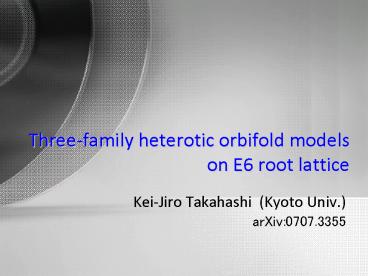KeiJiro Takahashi Kyoto Univ' - PowerPoint PPT Presentation
1 / 13
Title:
KeiJiro Takahashi Kyoto Univ'
Description:
How can we realize the Standard Model as a low energy effective theory of string ... Graph automorphism (outer automorphism) For ZnxZm orbifold, the classification by ... – PowerPoint PPT presentation
Number of Views:49
Avg rating:3.0/5.0
Title: KeiJiro Takahashi Kyoto Univ'
1
Three-family heterotic orbifold models on E6
root lattice
- Kei-Jiro Takahashi (Kyoto Univ.)
- arXiv0707.3355
2
Introduction
- How can we realize the Standard Model as a low
energy effective theory of string theory? - As a perturbative approach, we assume the
compactification - 4D 6D compact space
- Several ways are proposed so far
- Heterotic string ? Calabi-Yau,
-
orbifold, -
fermionic construction, - Type II string ? Intersecting D-brane,
flux, - We construct new (rather missed) orbifold models
based on E8xE8 heterotic string.
Internal space
3
A standard-like story to the Standard Model
scale
String theory
18
10 GeV
TypeIIA,B, Heterotic
UV completion
mass 0
1Mst
2Mst
3Mst
Massive states are decoupled in low energy scale.
10D SUGRA
N1 Gravity
N1 YM
compactification
matter
6?
10 GeV
4D SUGRA
moduli
Hidden sector
By gaugino condensation, SUSY breaking may occur.
3?
SUSY SM
10 GeV
2
Standard model
Gravity
10 GeV
4
Orbifold (as compact space )
- We can obtain an orbifold to identify the points
on torus by rotation and shift. - Examples for Z2 orbifold on SO(4) and SU(3)
lattices.
? compactification lattice
P point group (rotation)
Boundary cond. X(2p) ?X(0) v , ?
rotation, v shift (v ??)
Action of Z2
A fixed line by Z2
(Z2xZ2non-factorizable A.Faraggi et.al
hep-th/0605117, S.Forste, T.Kobayashi, H.Ohki,
K.T hep-th/0612044)
5
Geometry and structure ? spectrum
- An example of Z3 orbifold on factorizable torus
- In this description, the interaction of particles
could be interpreted as change of the loci in the
compact space.
3x3x327 twisted sectors
9 untwisted sectors
36 generations of matter
d H ? u
d
u
H
W, Z..
6
Non-factorizable lattices
- We define the shape of torus by the words of Lie
algebra. - We take direct products of these tori,
- and the compact space should be totally six
dimensions. - SU(3)xSU(3)xSU(3), G2xSU(3)xSO(4) ?
factorizable - SU(4)xSU(4), SO(8)xSO(4), SU(7), SO(12), E6 ?
non-factorizable
SU(3)
G2
SO(12)
SU(4)
SO(6)
E6
7
Point group elements of orbifold
- The elements of orbifold should act
crystallographically on torus, i.e. symmetry of
the lattice. - Weyl reflection
- Graph automorphism (outer automorphism)
- For ZnxZm orbifold, the classification by
- the coxeter elements is incomplete.
- We select two commutative elements
- as ZnxZm orbifold action.
(K.T. JHEP03(07)103)
(K.T with T.Kimura, M.Ohta)
8
E6 torus
- E6 root lattice
- Orbifold action of Z3xZ3
- 3 fixed tori appear in ?-twisted sector !
- ?F -sector includes 27 fixed points.
rotation
?-sector ?
This is similar for F, ?F-sectors.
2
9
E6 model for the standard embeddings
- An explicit model on Z3xZ3 orbifold on E6
lattice. - To satisfy the modular invariance we must embed
- the twist in 6D space to E8xE8 gauge space.
- Gauge group
- The massless spectrum
36 generations
singlets N1 Gravity N1 YM
10
An SO(10) model
- Quite simple assumptions
- Z3xZ3 orbifold on E6 root lattice
- gauge embeddings
- Gauge group
- No adjoint higgs! ? Not realistic.
- Assume the vector-like (7)s have large mass
(MGUT), the coupling of SU(7) become strong at
10 GeV.
visible
3-family matter
hidden
Messenger??
7
11
An SU(5) model
- Similarly
- gauge embeddings
- Gauge group
visible
hidden
12
The advantages of these models
- The origin of three generation of matter are
explained by the three fixed tori in a twisted
sector. - In Z3xZ3 orbifold, three point (Yukawa)
interactions , which are suppressed by e , are
generated by instanton effect. - They include strong coupling sector in the low
energy, - and may cause spontaneous SUSY breaking.
- Nevertheless they are toy models without adjoint
higgs.
-S
Hidden sector
strong
13
Summary
- We first construct heterotic orbifolds on E6 root
lattice and obtain very simple GUT-like models.
These models have some favorable features for
phenomenology. - In order to realize directly SU(3)xSU(2)xU(1)
models, we can add Wilson lines to this
construction, and it may lead to a more realistic
model. - In string theory different models are related by
dualities and symmetries. Some coincidence
between non-factorizable models and factorizable
models with generalized discrete torsion are
pointed out in hep-th/702176. It is valuable to
investigate geometries of compact space by
itself. - From UV to IR, it is a challenging issue to
construct more realistic model, that is
perturbative vacua of string theory.































